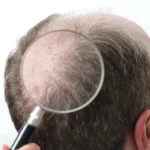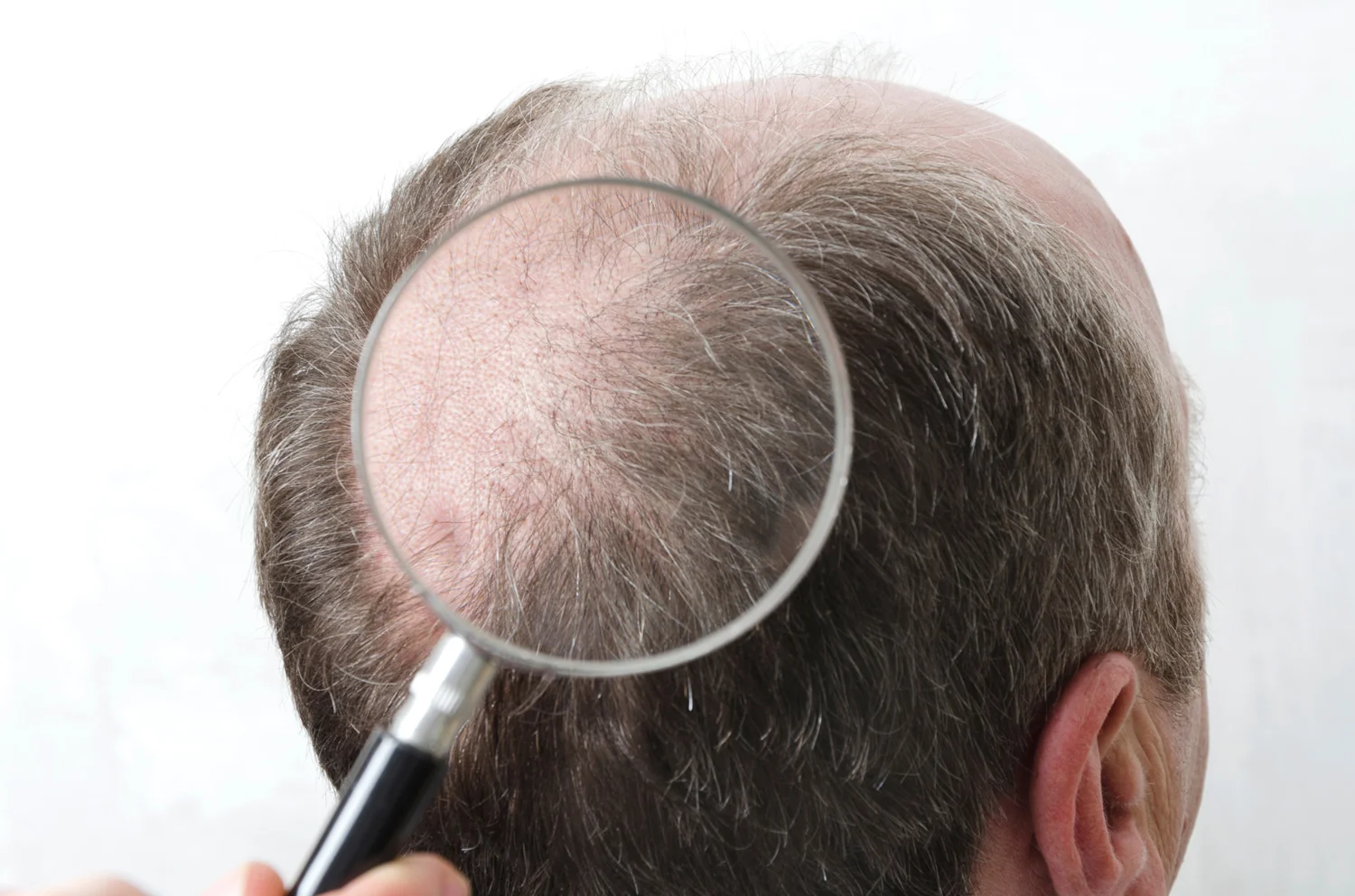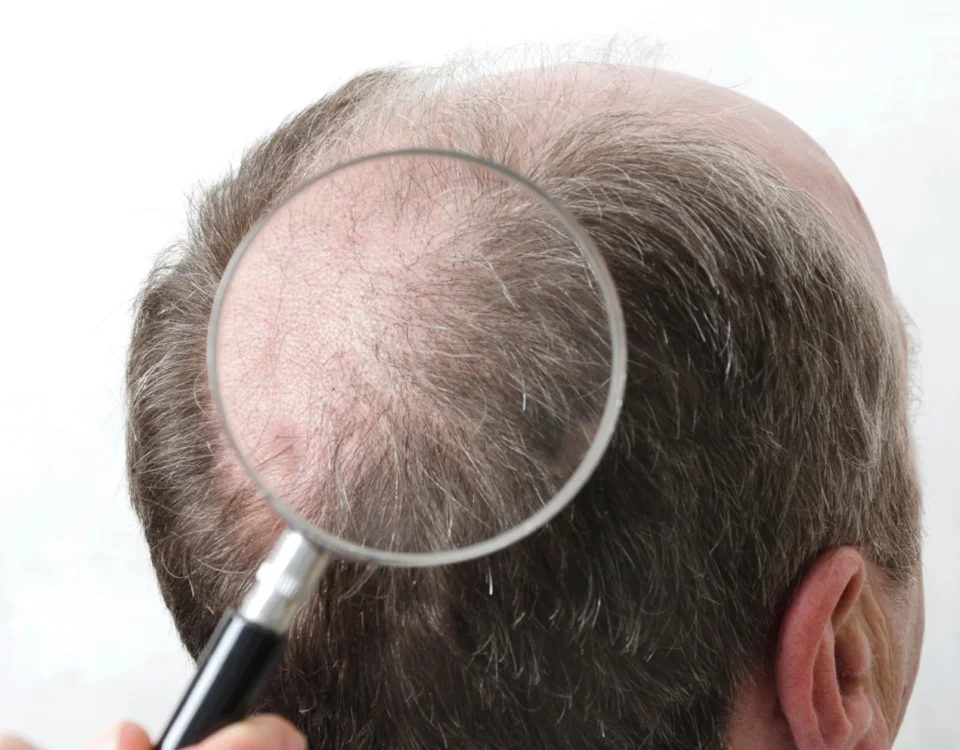
Hair Transplant in Poland
18 April 2024
Hair Transplant Androgenetic Alopecia
22 April 2024A receding hairline at the temples, commonly known as “receding hairline,” is one of the most frequent signs of androgenetic alopecia, especially in men.
While this condition does not pose a health risk, it can significantly impact self-esteem and one’s perception of their appearance.
As the receding hairline becomes more pronounced, many patients begin to seek effective solutions to restore their lost hairline.
One of the most effective and lasting ways to correct a receding hairline is through a hair transplant.
In this article, we explore modern hair transplant techniques, their effectiveness, and what patients can expect from the procedure.
Causes of a Receding Hairline
A receding hairline is primarily caused by the action of dihydrotestosterone (DHT), a hormone derived from testosterone, on sensitive hair follicles in the frontal and temple areas.
Under the influence of DHT, these hair follicles gradually miniaturize, leading to thinning hair and, ultimately, to hair loss.
This process is genetically determined and can begin at a young age, often in the mid-teens.
Hair loss in the temple area is typically the first stage of male pattern baldness (androgenetic alopecia), which may progress over time, resulting in a fully receding hairline and potential baldness at the crown of the head.

Is a Hair Transplant an Effective Solution for a Receding Hairline?
A hair transplant is widely recognized as the most effective method for restoring a lost hairline in the temple area.
Unlike other treatments, such as minoxidil or finasteride, which may only slow the hair loss process, a hair transplant allows for the direct restoration of density in areas where it is most needed.
A hair transplant for a receding hairline involves extracting healthy hair follicles from the donor area (usually the back or sides of the head) and transplanting them into the temple area.
Choosing the appropriate transplant technique is essential to achieving natural and lasting results.
Modern Hair Transplant Methods for a Receding Hairline
At Dr Art Clinic in Wrocław, two main hair transplant methods are used: Sapphire FUE and DHI.
Both methods are highly effective and precise, which is especially important when reconstructing the hairline.
Sapphire FUE (Follicular Unit Extraction)
The Sapphire FUE method is an advanced hair transplant technique in which hair follicles are extracted from the donor area using a micromotor and then implanted into the temple area.

A key aspect of this method is the use of sapphire blades to open microscopic channels in the scalp.
Sapphire blades, with their exceptional precision, enable the creation of very small, uniform, and smooth incisions, minimizing the risk of damage to surrounding tissues.
This results in faster healing and a more natural appearance of the transplanted hair.
With this method, transplanted hairs can be precisely placed in the temple area, allowing for a restored hairline with the ideal density and growth angle.
Sapphire FUE is particularly effective in recreating a natural-looking hairline, making the results nearly indistinguishable from natural hair.
DHI (Direct Hair Implantation)
The DHI method, or Direct Hair Implantation, is another advanced transplant technique, especially recommended for patients with a receding hairline who seek minimal invasiveness and precise results.

In this technique, hair follicles are directly implanted into the scalp using a Choi Pen tool, which simultaneously creates the channel and places the graft, eliminating the need for pre-opening channels.
DHI allows the physician to control the depth, direction, and angle of each hair implant, which is crucial in hairline reconstruction.
This approach achieves a natural look, enabling patients to enjoy a fuller hairline with no visible signs of transplantation.
An additional advantage of the DHI method is a shorter recovery time and the option to perform the procedure without shaving the hair, making it particularly appealing to some patients.
Procedure Process and Recovery
The hair transplant procedure for a receding hairline begins with a thorough consultation with a physician who assesses the patient’s health, the degree of hair loss, and individual expectations.
After selecting the appropriate transplant method, the procedure begins, lasting from several hours up to a full day, depending on the number of grafts to be transplanted.
During the procedure, the patient is under local anesthesia, ensuring comfort and a pain-free experience.
After the procedure, the patient receives detailed instructions on caring for the treated area, including avoiding physical exertion, careful washing, and avoiding sun exposure for a few weeks.
Initial results become visible after a few months, but the full outcome of the transplant can be assessed after 12–18 months, once the transplanted hair has fully healed and grown back.
Benefits and Expectations After a Hair Transplant for a Receding Hairline
A hair transplant for a receding hairline offers numerous benefits that can significantly improve a patient’s quality of life.
Restoring the hairline brings a younger appearance and boosts self-esteem, positively impacting both personal and professional life.
Thanks to advanced techniques like Sapphire FUE and DHI, patients can expect lasting, natural-looking results without the need for further intervention.
It’s important to remember that a hair transplant is a surgical procedure that should be performed by experienced specialists in a reputable clinic.
Only then can patients be confident that the results will be satisfactory and long-lasting.
A receding hairline is a common and often frustrating symptom of androgenetic alopecia, but modern hair transplant techniques like Sapphire FUE and DHI offer an effective solution.
A hair transplant for a receding hairline is an investment in appearance and self-confidence that yields permanent results.
At Dr Art Clinic in Wrocław, patients can count on professional care, the latest technology, and a personalized approach to each case.
We invite you to schedule a consultation at our clinic, where our specialists will help you regain a natural-looking hairline and enhance your quality of life.
Hair Transplant for Receding Hairline – Adam’s Story
Patient: Adam, 36 years old
Adam, a 36-year-old IT specialist from Wrocław, had been dealing with increasingly visible receding hairline for several years.
Although his career was progressing well, and his personal life was on track, Adam started to feel growing discomfort due to the hair loss around his temples.
The issue began at age 28 when he noticed his hairline starting to recede.
Initially, he considered it a natural part of aging, but over time, the receding hairline became more noticeable, affecting his self-esteem.
Adam tried various remedies, such as specialized shampoos, dietary supplements, and topical medications, but the results were minimal.
Not only did the receding areas continue to grow, but they also made Adam feel less confident, especially in social and professional settings where appearance played a significant role.
The Decision to Undergo a Hair Transplant
After several years of struggling with his receding hairline and feeling frustrated with the lack of noticeable improvement from other treatments, Adam decided to seek a more permanent solution.
Following a thorough exploration of available options and reading numerous reviews, he scheduled a consultation at Dr Art Clinic in Wrocław, known for its modern hair transplant techniques.
During the consultation, the doctors conducted a detailed assessment of Adam’s hair condition, evaluating the degree of hair loss and the potential benefits of a transplant.
They recommended the Sapphire FUE method as the most suitable approach to restore his natural hairline and fill in the receding areas.
Treatment Plan
Adam and his doctor established a treatment plan that involved transplanting approximately 3,000 grafts to effectively cover the temple area.
It was also planned to slightly lower and shape the hairline to create a natural appearance.
The goal was to design an aesthetically pleasing hairline that would blend seamlessly with the existing hair, ensuring adequate density.
Procedure
The hair transplant procedure using the Sapphire FUE method was completed in a single day.
Adam received local anesthesia, ensuring comfort throughout the entire process.
Hair follicles were carefully extracted from the donor area at the back of the head, where the hair is naturally resistant to the effects of dihydrotestosterone (DHT) – the hormone responsible for androgenetic hair loss.
Using sapphire blades, the doctors made microscopic incisions in the temple area, taking into account the natural direction, angle, and depth of the hair growth to achieve the most natural-looking result.
The grafts were then precisely placed in the prepared channels, allowing for the desired density and even distribution of hair.
Recovery
After the procedure, Adam received detailed instructions on how to care for the transplanted areas to ensure optimal healing and growth of the new hair.
During the first few days, he avoided strenuous physical activities, tight headwear, and excessive sun exposure.
Small scabs began to fall off after about a week, and full healing occurred over the following few weeks.
Adam was pleasantly surprised at how quickly he could return to his daily activities, though he had to wait several months for the first visible results.
Initially, the transplanted hair shed, which is a normal part of the healing process, and new hair began to grow around three months later.
Adam’s case illustrates how a hair transplant for a receding hairline can transform not only a patient’s appearance but also their quality of life.
Thanks to the modern Sapphire FUE method and careful planning, it was possible to achieve natural and lasting results.
A hair transplant is an investment that offers long-term benefits, enhancing both appearance and well-being, as Adam’s story confirms.
Frequently asked questions

Is a Hair Transplant for a Receding Hairline a Permanent Solution?
Yes, a hair transplant for a receding hairline is a permanent solution because the transplanted hair follicles are taken from the donor area (typically the back and sides of the head), where hair is naturally resistant to the effects of dihydrotestosterone (DHT).
DHT is the hormone responsible for androgenetic hair loss, which leads to receding hairlines.
The transplanted hair retains its characteristics and remains resistant to this hormone, meaning it won’t fall out as the original hair did in the temple area.
This is why hair transplantation is considered an effective and permanent solution.
What Are the Most Effective Hair Transplant Methods for a Receding Hairline?
The most effective methods for a hair transplant to restore a receding hairline are Sapphire FUE (Follicular Unit Extraction) and DHI (Direct Hair Implantation).
- Sapphire FUE: This method involves extracting individual hair follicles (grafts) from the donor area at the back and sides of the head, which are resistant to the effects of DHT. The grafts are then transplanted into the receding areas. A key aspect of this technique is the use of sapphire blades to create microscopic channels in the scalp. The precision of sapphire blades allows for finely shaped channels, minimizing scarring, speeding up healing, and achieving a very natural hairline.
- DHI (Direct Hair Implantation): In this method, hair follicles are directly implanted into the receding areas using a specialized tool called a Choi Pen. This tool simultaneously creates the channel and inserts the graft, ensuring maximum precision. DHI allows for meticulous control over the depth, angle, and direction of each transplanted hair, which is particularly important for recreating a natural-looking hairline. This method is also less invasive and requires a shorter recovery time.
How Many Grafts Do I Need for a Hair Transplant for a Receding Hairline?
The number of grafts needed depends on the extent of the receding hairline and the patient’s individual needs.
For moderate hairline recession, typically between 1,000 and 3,000 grafts are required.
The exact number will be determined by the doctor during a consultation, considering factors such as hair density in the donor area, patient expectations, and the desired shape and position of the hairline.
It’s essential to choose the appropriate number of grafts to achieve a natural look and a satisfactory aesthetic result.
How Long Is the Recovery Process After a Hair Transplant for a Receding Hairline?
The recovery process after a hair transplant for a receding hairline typically takes from a few days to a few weeks.
The first 7–10 days post-procedure are crucial, as small scabs may appear on the scalp, which will gradually fall off.
During this time, patients should avoid strenuous physical activity, wearing tight headgear, and direct sun exposure.
After about two weeks, most patients can resume their daily activities.
Initial results of the transplant can be seen after approximately three months, but the full effect is typically assessed after 12–18 months, once the transplanted hair has fully healed and regrown.
Is a Hair Transplant for a Receding Hairline Painful?
A hair transplant for a receding hairline is generally not painful, as the procedure is performed under local anesthesia.
The patient may feel slight discomfort when the anesthesia is administered, but the actual transplant process is painless.
After the procedure, mild sensations of tightness, itching, or discomfort may occur in the donor and recipient areas, which typically subside within a few days.
If necessary, the doctor can prescribe pain relief medication to ensure the patient’s comfort during recovery.
Most patients describe the process as less painful than anticipated, with any discomfort being easily managed.
What Are the Potential Side Effects of a Hair Transplant for a Receding Hairline?
A hair transplant is generally a safe procedure, but like any surgical treatment, it may come with some side effects.
The most common ones include:
- Swelling: Swelling may occur on the forehead and around the transplant area, usually subsiding within a few days.
- Redness and Scabbing: Small scabs may form in the transplanted areas, which typically fall off within 7–10 days.
- Itching: This is a natural skin response to healing but can be alleviated with appropriate treatments recommended by the doctor.
- Temporary Hair Shedding (Shock Loss): In the first few weeks after the procedure, transplanted hairs may fall out, which is a normal part of the healing process. New hair growth typically begins around three months after the procedure.
- Scarring: When performed correctly, the risk of scarring is minimal, especially with techniques like Sapphire FUE.
When Can I Return to Work After a Hair Transplant for a Receding Hairline?
Most patients can return to work a few days after a hair transplant, depending on the type of work and their comfort level.
If the job involves intense physical activity or exposure to factors that may impact the healing process (e.g., sun, dust), it’s recommended to wait at least a week to 10 days before resuming work.
For office jobs, returning to work is possible within 2–3 days after the procedure, although some patients prefer to take a week off to fully rest and minimize the risk of infection.
Does a Hair Transplant for a Receding Hairline Require Further Treatments?
A hair transplant for a receding hairline is typically a one-time procedure that provides permanent results, as the transplanted hair is resistant to DHT.
However, depending on the progression of androgenetic alopecia, a patient may choose to undergo additional transplants in the future to fill in other thinning areas or adjust the hairline.
It’s also essential to continue proper hair care and follow medical advice to maintain hair health and minimize further hair loss in untreated areas.
Is Everyone a Suitable Candidate for a Hair Transplant for a Receding Hairline?
Not everyone is an ideal candidate for a hair transplant on the hairline.
Key factors affecting eligibility include:
- Overall Health: The patient should be in good general health and free of medical contraindications for a surgical procedure.
- Adequate Donor Hair Supply: Patients must have a sufficient number of healthy, DHT-resistant hair follicles in the donor area to ensure a successful transplant.
- Realistic Expectations: Patients should have realistic expectations for the results. The doctor will discuss achievable outcomes based on the patient’s unique case.
What Are the Costs of a Hair Transplant for a Receding Hairline?
The cost of a hair transplant for a receding hairline can vary significantly based on several factors, including:
- Transplant Method: Techniques like Sapphire FUE or DHI may differ in price due to variations in procedural complexity and technology.
- Number of Grafts Required: The more grafts needed, the higher the cost.
- Experience and Reputation of the Clinic: Highly skilled specialists and reputable clinics may charge more but offer superior quality and outcomes.
In Poland, the cost for a hair transplant targeting the hairline can range from several thousand to over ten thousand PLN.
An exact estimate can be provided during a clinic consultation, where the doctor assesses the scope of the procedure and the patient’s specific needs.
A hair transplant for a receding hairline is an effective, lasting solution for individuals dealing with a receding hairline — a primary symptom of androgenetic alopecia.
Thanks to advanced techniques like Sapphire FUE and DHI, it’s possible to achieve natural-looking results that not only improve appearance but also significantly boost patients’ confidence.
The choice of method and a personalized approach are essential for the procedure’s success
Dr Art Clinic in Wrocław offers patients a high standard of professionalism, cutting-edge technology, and care from world-class specialists.
The clinic provides a comprehensive approach to hair loss, from detailed diagnostics and meticulously planned hair transplants to thorough post-operative care.
This enables each patient to regain a natural-looking hairline and enhance their quality of life.
If you’re dealing with a receding hairline, consider a consultation at Dr Art Clinic , where expertise and modern methods are combined with patient-centered care.






